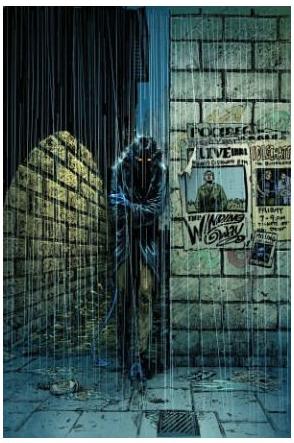Date read: 11/16/09
Book from: Personal collection
Reviewer: Emera
(Nightcrawler: The Winding Way collects Astonishing X-Men: Nightcrawler #7-12.)
After being seriously wounded in an inexplicable attack, Nightcrawler struggles to escape the nightmarish memories of his past: his youth in Germany behind the scenes of a circus, his unwilling murder of his brother, and his eventual enslavement in an American circus. Once recovered from his injuries, Nightcrawler retraces his history both in Germany and in America, seeking to understand the forces that seem determined to dredge up his past and threaten the boundaries of the mystical worlds.
 Hmm… well, for starters, I don’t like Darick Robertson’s art (I’ve also seen his work in The Boys). Though a few of his cover spreads for this mini-series are nicely textured and moodily desaturated (e.g. the cover above, which I quite like), his art within the run is hilariously inconsistent, and flat-out terrible on several pages where it’s obvious that he had to rush it. He’s also one of those people who can’t draw women without certain parts of their anatomy straining at their improbably tissue-thin, vacuum-suctioned-to-the-skin clothing. Also, not so much a fan of Matt Milla’s coloring, either, as it’s in the digital style of which I am an anti-fan – hard, oversaturated, metallic colors.
Hmm… well, for starters, I don’t like Darick Robertson’s art (I’ve also seen his work in The Boys). Though a few of his cover spreads for this mini-series are nicely textured and moodily desaturated (e.g. the cover above, which I quite like), his art within the run is hilariously inconsistent, and flat-out terrible on several pages where it’s obvious that he had to rush it. He’s also one of those people who can’t draw women without certain parts of their anatomy straining at their improbably tissue-thin, vacuum-suctioned-to-the-skin clothing. Also, not so much a fan of Matt Milla’s coloring, either, as it’s in the digital style of which I am an anti-fan – hard, oversaturated, metallic colors.
Storywise, this is also not amazing. Schmaltzy dialogue and narration, predictable plotting. The only bits I enjoyed were the angsty Nightcrawler flashbacks, and that’s partly just me being a Nightcrawler fangirl – there isn’t that much genuine emotional depth to them. I’d probably only reread it for those bits, though, so at least it has some reread value.
Also… I’d love to use stronger language here, but I’m going to control myself and just say, enough with the Wolverine cameos. Really. Are there really that many people on the face of the earth who would pick up a comic title purely because it includes a certain Canadian flaunting his body hair and tossing off predictable lines involving the word “bub”? (Don’t answer that question, and yes, I’m sure I’m late on the bandwagon of people who complain about that.) In general I’m losing interest in the Marvel superhero universe, or at least the mainstream superhero titles. It’s so frustrating that their overall storylines are really compelling, but they generally end up being killed by the writing, or the art, or both. Case in point: I love that the Nightcrawler series concept is to have him investigate the mystical and paranormal events that the X-Men generally don’t handle, but the end product is hardly worth reading.
…That was a lot of spleen.
Go to:
Roberto Aguirre-Sacasa

